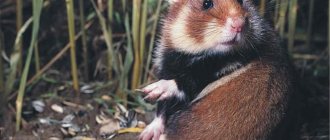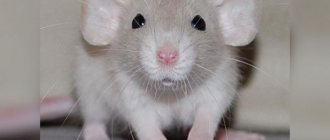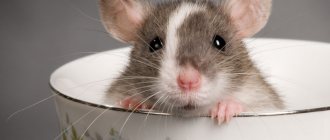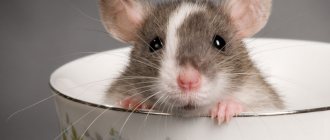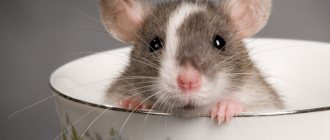Nature has given life to hundreds of amazing creatures. Some amaze with their beauty, others with their strength, and others with their size. The gray rat tries not to stand out and be seen as little as possible. Perhaps this is why few people know about the unique mental abilities of this animal, not to mention its gift of clairvoyance. The ability of rats to adapt to living conditions in which no other mammals can exist is also impressive.
The gray rat has not received either strength or large size from nature, but, being small and inconspicuous, it is capable of destroying millions of people, leaving them without food or infecting them with deadly infections. Humanity has been fighting rats for centuries, but has not yet come half a step closer to victory. In some amazing way, tailed rodents masterfully avoid all traps, survive all adversity and continue to thrive. We invite you to get acquainted with their amazing life, very short, but bright and extraordinary, in many ways similar to the lives of people.
History of origin and settlement
Paleontologists have found that the gray rat species appeared in the Pleistocene, that is, approximately 2.5 million years ago. Other rodents, including mice, already existed by that time. The next ice age that began killed many of them, but gave the gray rat the opportunity to establish itself as the most progressive species. In those distant times, these animals lived only in the territory of modern China.
From the south and east their habitat was limited by seas and oceans, from the west by insurmountable mountains, and from the north by a glacier. When it began to melt, the rats moved to new lands. Colonization proceeded unusually slowly. For more than 13 thousand years, they only reached the present-day Transbaikalia, where to this day they live well in natural conditions. Rats were encouraged to spread across the planet by people who began to actively engage in trade and navigation. About 2,000 years ago, tailed stowaways entered India on ships, from there they got to Persia, and then moved to Europe, America, Africa, and Australia. Now they are not found only in places where they have absolutely nothing to eat - in Antarctica, in the Arctic and in certain areas of the desert.
Mechanical methods
The so-called “mechanical methods” include the installation of traps and traps. The most common are large spring rat traps and small mouse traps. They must be installed close to entrance doors, holes and along walls.
An ordinary spring mousetrap.
To increase the effectiveness of the trap, you should put a piece of food in it. As bait, you can use a piece of lard, sausage, cheese or bread dipped in vegetable oil. Before placing traps, you need to wash the traps, as the human smell repels the animals. It is also recommended to lubricate them with something attractive to rodents. For example, glycerin, syrup, vanillin or vodka. Try not to touch the trap and bait without rubber gloves.
When a rodent runs into the cage, the door slams.
For smart animals that deftly avoid set traps and do not eat poisoned food, try preparing the following “cunning” bait. Combine wheat flour and dry building plaster in a ratio of 1 to 1. Pour the bait onto a plate at the rate of 1-2 tbsp. for one rat. Place a container of water nearby. Having eaten the bait, which tastes and smells no different from ordinary flour, the animal will soon die. The mixture will harden in her stomach in 5-10 minutes.
Traps should be changed every 5-10 days and checked regularly. If the mice do not show interest in the baits or have learned to get them out of the trap, this method is useless.
Etymology of the name
In the scientific world, the name of the gray rat sounds like Rattus norvegicus. It appeared after a biologist from England, John Berkenhout, saw these animals in the port and wrote a description of them. He was sure that ships arrived in England only from Norway, so with a clear conscience he dubbed the species he “discovered” the Norwegian rat, although these rodents did not exist in that country at all at that time. And they arrived in Foggy Albion, most likely, from Denmark and could well have become Danish rats if Sir Berkenhout had a little better understanding of navigation. Pasyuk, or Patsyuk, is another of their names, familiar to many Russians, Ukrainians and Belarusians. So, what are the heroes of our article?
Ways to control rodents
Let's look at the most effective ways to protect your home and property.
Toxic substances
There are many types of poisons in specialized stores.
All poisons can be divided into strong and weak effects.
- The first category includes zinc phosphide. The poison acts quickly . Once in the stomach, it begins to react with hydrochloric acid and forms hydrogen phosphide, which stops breathing. A 3% concentration of poison is suitable for the death of an animal. It is good because it will not cause poisoning in other animals if they eat a poisoned rat.
- Long-acting substances are more suitable for controlling small rodents. It may take quite some time until the poison accumulates in the body and destroys the animal. In addition, the gray rat’s body is more resistant to poison and can get used to it, so from time to time the type of substance will have to be changed.
What types of poison can be used?
- Treats soaked in poison (grain, cheese, bread, pieces of meat). The method is effective and most common.
- Liquid baits are chemicals dissolved in water and milk.
- Powdered chemicals - for pollinating burrow exits and other places where barn rats might be seen.
- Gaseous chemicals - used, for example, to irrigate burrows. This method should be used with caution, especially in residential areas.
Mechanical traps
Advice! Do not fully charge the mousetrap at first. Let the rodents eat the left baits several times. Rats will get used to taking the left treat and will not suspect that a click will soon occur and the trap will work.
Placing a mousetrap is the easiest way, but not reliable. The barn rat is larger than the vole, so a standard simple mousetrap will not work for it.
In addition, after catching 1-2 rodents, they do not want to go into the mousetrap even with the most exquisite bait.
Ultrasonic repellers
Quite an effective way . Modern devices are effective. Ultrasonic waves negatively affect the psyche of rodents and force them to leave populated areas.
Attention! For good results, the device must work constantly. In addition, when purchasing, it is important to compare the size of the area where the device will be used and the duration of the emitted wave. A universal, standard repeller is suitable for a barn, barn, or home. If you are going to install it on a large area, take care of purchasing several devices.
Path closure
Another not bad way to fight. You can get rid of gray rats in your house or barn by blocking the paths.
Try to figure out the passages, loopholes, paths along which the pasyuk makes its way into the house, and sprinkle calcium chloride . Rodents cannot tolerate this powder.
Rat holes and passages can be covered with cement and crushed glass . It will be extremely difficult for them to gnaw through such a wall.
All methods are good in the fight against the hated gray rodents.
In order for the work to be done effectively, it is better not to settle on any particular method, but try to change them or use them in combination.
Then your home and area will not be afraid of even such unpleasant pests as gray rats.
Gray rat: description
These animals have an unattractive appearance. The body of adult males can grow up to 25 and sometimes up to 30 cm in length, plus a bald, thin tail about 20 cm long. The body and tail of females are slightly shorter. The muzzle of gray rats of any sex is not elongated, like their black relatives, but more rounded, the ears are small, the eyes are small, similar to black beads.
The coat color, as the name suggests, is gray, the belly and sometimes the chest can be white. There are guard hairs along the body of rats. They are longer and thicker. In individuals living close to people, the coat color has a reddish or brownish tint, which is why many consider them not gray, but brown. Rodents bred in captivity are distinguished by an incredible variety of colors. Here you can find any combination of white, black, red and brown, although the species is still called the gray rat.
Their teeth do not fall out, but grow throughout their lives, so the animals must constantly gnaw on something to wear them down.
Appearance of a rodent
The general appearance of the animal is known to everyone: the gray rat is a medium-sized rodent, and of all the rats in Russia it is the largest. The only larger ones are gophers, marmots, beavers, nutria and other rodents that are not rats.
The length of the animal reaches approximately 19-24 cm, the length of the tail is 12-19 cm. It is noteworthy that the tail of the gray rat is never longer than the body, which is one of its differences from the black rat.
Photo of a large gray rat:
The color of the pasyuk's coat is usually not completely gray, but brownish, although young rat pups are precisely gray, and as they grow older, they develop a reddish coloration. The animal's abdomen is light, almost white. Very rarely - in about one animal out of 1500-2000 - pure black individuals are found. However, despite the coloring, from the point of view of species they continue to remain typical gray rats.
On a note
The Pasyuk's fur contains a large number of guard hairs, longer than all the others. Therefore, gray rats often look somewhat disheveled and “untidy” (as if dirty).
The picture shows a gray rat having a meal:
The tail of a rat is an object of disgust for many aesthetes. It is naked, covered with sparse short transparent hairs and a rough epidermis resembling scales.
Gray rats are quite easily distinguished from their relatives, with whom they live together in different parts of their range. For example:
- Reliable species identification of gray and black rats is carried out by measuring the mass and size of the body, as well as the length of the tail: the pasyuk is larger, heavier, its tail is always shorter than the body. The appearance of the animal is also assessed - the black rat has larger eyes and ears, an elongated muzzle, and a more “fluffy” tail. Experts are also able to distinguish these species based on their skeletal features. For example, the pasyuk has fairly straight parietal crests of the skull, while in the black rat they are strongly curved. It is noteworthy that there are light populations of black rats, the representatives of which are very similar in color to their gray counterparts;
- The pasyuk differs from the Turkestan rat in having coarser fur and larger size.
The photo below shows a gray rat:
And here it is black:
And the appearance of the gray rat itself is heterogeneous. There are at least two of its subspecies - Rattus norvegicus caraco, indigenous, smaller, common in Transbaikalia, the Far East, Mongolia, Korea and Eastern China. And the main one is Rattus norvegicus norvegicus, found in all other parts of the range.
Interestingly, the Latin name for the gray rat is a consequence of a scientific error. This species was described by the British zoologist John Berkenhout, who noticed that pasyuks are most numerous in port cities. He decided that the animals sailed to England on ships from Norway, and suggested that it was in Norway that their natural habitat was located.
As a result, he gave the animals the specific epithet “norvegicus”. The irony is that in reality, at that time, gray rats had not yet penetrated into Norway, and most likely came to England from Denmark.
However, the subspecies that has spread throughout the world is named by the same epithet, because it was the one that was described for the first time, for science it is nominative, and according to tradition, its subspecies name duplicates the specific one. Such a forced double mistake...
On a note
Today, taxonomists believe that domestic and laboratory rats have developed a sufficient number of specific features to distinguish them into a separate subspecies.
On agricultural lands in Russia, the gray rat can be confused with some other animals. Most often, a water vole is mistaken for it - a rodent of the hamster family, which is really similar to the pasyuk in color and body size. But the water vole has shorter legs, and the head is even more massive and less elongated.
Photo of a water vole:
And for comparison - a gray rat:
In northern regions, rats (especially young ones) are sometimes confused with voles or lemmings. Upon closer inspection, such errors are quickly revealed: rats are usually larger, have a slimmer body and a longer tail.
The mistakes themselves are due to the fact that the animals are noticed out of the corner of the eye when they make their way through the grass or quickly hide in holes. In addition, the further north you go, the less often representatives of this species are found outside human habitation, which means that an animal caught somewhere in the taiga is most likely not a rat.
Features of behavior
These creatures prefer to live in groups and endure loneliness only when necessary. The family always has a main male, a pair of his deputies, a harem of females and simple members (young individuals, weak males) who do not take part in reproduction. There is no mutual assistance between them, just like there is no communal labor like ants or bees. Among rats, everyone cares only about themselves, but if a stranger suddenly joins the family, they kill him together, although, in principle, they are not aggressive and do not attack unnecessarily.
The gray rat also resorts to the help of its fellow tribesmen to obtain food. The photo above shows how they steal birdseed as a well-coordinated team. Another feature of a collective organization is the fact that a poison that kills one member of the family will be avoided by others. These animals are smart and quick-witted. An experiment was conducted in which cheese was placed in a maze, and the rat not only quickly found the treat, but also remembered the path, and if the food was moved to another place, the animal no longer used the old path, although the smell of cheese remained there.
Why are rats dangerous to health?
Rats are carriers of pathogens of dangerous diseases. The list of diseases includes typhus, Derrick-Burnett disease, leptospirosis, hantavirus pulmonary syndrome, toxoplasmosis, tulyamalaria, toxocariasis, fevers, streptobacillosis. They can be infected with rabies, but cases of transmission of rabies from rats to humans are rare. The main danger lies in borne diseases. They contaminate food and water sources with saliva, urine and excrement. They can become a source of fire, chewing through wires and causing a short circuit.
Gray rat: habitat
In nature, these rodents settle only where there are sources of water, without which they cannot survive even three days. They prefer lowlands overgrown with vegetation, but can also climb mountains. They don't bother people at all. Only rats that live near humans are harmful. Some are permanent tenants, others are temporary, leaving in the spring to live freely and returning in the fall. They live in boiler rooms, basements, barns, and can live in high-rise buildings, but they rarely rise above the 9-10th floor.
In cities, rats have chosen sewer systems and subways, port docks and store warehouses. In villages, they live on livestock farms, poultry houses, and fruit and vegetable processing factories. One rat family controls a territory of up to 2 thousand m2, which all its members regularly mark with urine. In case of food shortage, rodents can expand the boundaries of their kingdom.
Harm to human farmer
In a household, an ordinary rat causes quite a bit of damage.
- They eat and steal harvests of grain, beans, and beans from barns. They damage storage containers (bags, boxes, boxes). They chew vegetables and fruits.
- In a suburban area, rodents prefer to feast on vegetables, berries, fruits, roots of plants and garden flowers.
- Pasyuki gnaw through the walls of buildings and barns, damaging furniture and wires. Chewing not only affects the appearance of a residential building, but can also cause short circuits and fires.
- Rats pose a danger not only to human health. Cases of rodent attacks on pets are not uncommon.
Rat houses
In nature, gray rats build their home in a hole about 80 cm deep. The length of the corridor reaches several meters. In the very depths, the animals make a nest, insulating it with blades of grass, feathers, and hairs. The common gray rat, living close to the water, in order to avoid flooding during floods, settles in hollows or builds a nest in a tree. Rodents that live near people build nests from all available materials. They can make kubla in things, for example, in a closet that is rarely looked at, in carpets rolled up for storage, in hay that has been folded for storage. In nests, females care for babies, and several broods can be in one place at the same time, and mothers care for the children together.
Signs of infection
Norway rats are difficult to spot during daylight hours. Detection during the daytime is a sign of severe infestation. The presence of holes in the area adjacent to the building is also an indicator of infection. Also signs of infection are chewed food and communication cables; capsule-shaped excrement scattered along the most frequently used passages and passages; noises - rats can climb walls, so you can hear a characteristic scratching sound; rustling in the area of floors and interfloor ceilings; prints - in dusty places, on the ground or sand, you can find rat paw prints.
Nutrition
What does this rodent eat? The gray rat is an omnivore. In nature, its diet consists of insects, lizards, chicks, bird eggs, cereals, root vegetables, and fruits. Rodents living near water eat small fish, mollusks, and crustaceans. Rats that settle in populated areas eat everything that they can steal from a person - any prepared food, any products, garbage, leftovers. It’s hard to understand why, but they chew paper, clothes, shoes, polystyrene foam, wooden products, electrical wiring - in short, everything that their powerful teeth can bite through. In villages, these little monsters eat chickens, newborn rabbits, and bite off the paws of adult rabbits that are locked in small cages. Male rats even eat their own children. Females are a little kinder; they eat only those babies that seem weak to them. They can survive only 4-5 days without food.
Prevention measures
To ensure that rats are as little interested in your home as possible, you need to monitor its condition and follow the following recommendations:
- do not leave trash and keep order in the area around the house;
- eliminate the presence of even the smallest through holes in the walls or roof;
- get rid of sources of standing water on the site;
- do not leave leftover food outside at night;
- get a cat or dog of a breed that is excellent at hunting rodents.
Reproduction
Fantastic fertility explains why, despite all the measures taken, the gray rat population increases every year. Reproduction in nature of these animals is seasonal, but in populated areas, where there is always food and warm shelter, it is year-round. Females bear offspring for about 3 weeks. There are most often about 10 rat pups in a litter, but there are known cases when there were up to 20. After lambing, 18 hours later, the new mothers do not refuse to mate again. Babies enter the world as tiny helpless lumps weighing up to 5 g. They are blind and naked. Their mothers clean them, feed them milk, and warm them. On the 14th, or less often on the 17th, the children’s eyes open, and after another 7-8 days they begin adult life. Young females rarely mate immediately. As a rule, this process begins within a year.
Interesting Facts
Despite the harm the Gray Rat causes to humans, one cannot fail to note the high intelligence of this animal. Of the huge number of facts confirming this, in particular it is worth highlighting the following:
In France at the beginning of the last century, the food market was closed and was about to move to another location. The day before the move, all the rats that lived in this market, as if on command, got up and went to the place where the market was supposed to move. Local residents were incredibly surprised, because the relocation of the market was only mentioned in the newspapers.
Once in a warehouse with dairy products, rodents found a way to get to kefir, which was packaged in glass bottles with a narrow neck. Pasyuki easily opened the foil caps and, sitting on a nearby bottle, lowered their tail inside. Then they took out the tail, licked all the kefir off it and put it back into the bottle.
We recommend reading: 20 facts about rats that you definitely didn’t know.
Gray rat or Pasyuk.
Achievements
The gray rat (pasyuk), if nothing threatens it, is very good-natured, busy only with getting food, and in search of it it can cover up to 20 km in a day. If she has to flee, she is able to reach a speed of 10 km/h, jump over an obstacle up to 2 m high, dive, swim more than 20 km. There are societies that organize rat Olympics, which include the so-called “pentathlon” - running, jumping, overcoming obstacles (climbing), lifting weights and tightrope walking.
A rodent can stay in water for up to 4 days. It likes the climate to be mild, but even in temperatures down to -18 °C it lives without any particular difficulties, and even reproduces. Confirmation of this is rat nests with live pups found in freezers, made in animal carcasses. They are also comfortable in boiler rooms, where the air temperature is about +45 °C. Rats do not die from radiation up to 300 roentgens/hour, and they are able to feel it with their nose.
How to force the management organization to destroy rodents in the house?
It should be kept in mind that even if one rat was spotted in an apartment, this is a sure sign that a colony of rodents is already living in the house. Since rats almost never settle in apartments, but come to them only in search of food.
The management company is responsible for the maintenance of common property, ensuring the safe living of citizens, and compliance with sanitary standards. Her responsibilities include ensuring regular deratization and disinfestation of common areas, which include basements, technical rooms, stairs and landings, elevators and elevator shafts, and common corridors.
So the first authority to contact if rats appear in the house is the management company. Residents need to write a statement in which they demand pest control, referring to regulations, the Decree of the State Construction Committee and the Rules for the maintenance of common property.
The application is submitted to the Criminal Code, receives a mark of acceptance and waits for a response within the 10 days required by law. After this period, representatives of the management organization are obliged to provide a response and set deadlines for carrying out measures to exterminate rodents.
Capabilities
The gray rat lives up to 3 years, but this is only if it is not sick, there is plenty of food, and there are no enemies. Usually such an idyll occurs only in laboratories or in home care. In nature, rats rarely live longer than one and a half years. Their abilities are unique. The fact that they anticipate earthquakes is not particularly surprising, because many animals can do this. But the fact that rats can predict where a shell will land is truly amazing. During the war, people, knowing about this talent of rodents, fled to those huts where the rats were hiding. A unique incident occurred in a market in France. It was moved to a new place, and already a day or two before, all the market rats had moved there, although, of course, no one informed them about this. Scientists have found that gray rats make about 5 thousand sounds, that is, they have their own “alphabet”.
These animals remember our faces and feel our character. They are able to pick up the slightest noise even in the 40 kHz range, which is used in electronic repellers. They distinguish two colors - blue and greenish. They dream, love classical music, and know how to laugh.
How do rats get into houses?
If they want, rats can get anywhere. Several factors contribute to this:
- these animals are very smart;
- rats have strong teeth with which they can chew through almost any material;
- Rodents jump quite high, climb vertical surfaces quite well and can even crawl into a narrow hole.
As soon as they appear in the yard, the rats immediately begin to explore the area and look for ways to enter the building. They know how to think logically, analyze information and draw conclusions. In addition, animals can act together.
Rats usually occupy the basement first. They can get into it through the door, technical openings, and communication joints. If there is even a small gap, rodents can easily chew through a passage (even in concrete).
Once in the basement, the rats begin to explore the entire building, moving through ventilation shafts, along sewer and water pipes, between ceilings, and inside walls.
War of blacks and grays
Once upon a time, black rats reigned supreme in Europe. They were known about and destroyed back in the ancient period, and in the Middle Ages they even organized teams of professional rat catchers. Despite all efforts, in the 14th century, millions of people died from a plague carried by black rats.
They are smaller than gray ones, do not like to move long distances and live in basements, preferring to live in attics and roofs. Now in cities the gray rat is replacing the black one, since it turned out to be less intelligent and weaker. If there is enough food, the grays do not bother their black brothers and crowd them out only when there is a shortage of food. In settlements remote from the sea, for example in Moscow, there are very few black rats left, but in coastal cities their numbers are huge, and on ships they still dominate.
Preventive protection measures
Rats are primarily attracted to food, water and shelter in the home. Therefore, it is necessary to limit access to each component.
Reduce food sources: Trash cans should be covered and emptied regularly. Bird food should be in specially designated feeders. Rats can even feed on bird excrement, so it is necessary to create separate feeding areas.
Reducing water sources: eliminating basement leaks; removal of direct sources of water, such as tanks, barrels from the surrounding area; eliminating the possibility of basement flooding.
Eliminate entry points: sealing holes and cracks in basements.
Benefits and harms
It is believed that a small gray rat is capable of leaving a sixth of the world’s population without food (photos of rodents are presented in the article). An adult needs only 20 g of food per day, but over the course of a year this figure increases to 10-12 kg. If you remember that there are now almost 18 billion rats on the planet, you can imagine how much food they eat.
Rats can infect humans with such deadly diseases as plague, Q fever, typhus, as well as non-lethal, but also very dangerous helminths, staphylococci and streptococci.
These animals spoil things, furniture, leave houses and even entire villages without electricity, gnawing through electrical wiring.
And yet they bring us benefits that are difficult to overestimate. Geneticists have found that the genes of humans and gray rats have more in common than those of humans and monkeys. This makes it possible to carry out highly complex genetic research, which is also facilitated by the incredibly fast reproduction of rodents. Scientists are testing new medications on them, studying many deadly diseases in order to understand how to treat us humans. Therefore, rats deserve not only hatred, but also respect.
Harm from rats
When approaching human possessions, rodents cause irreparable damage to garden crops, horticultural crops, poultry farming, and livestock farming. The appearance of rats in the house threatens with terrible diseases. This is why rats are dangerous to humans. Gray rats are carriers of more than 20 complex diseases:
- fever;
- tuberculosis;
- salmonellosis;
- typhus;
- plague.
They spread helminth eggs and more than 60 pathogens.
Rodents cause economic harm. The upper teeth are constantly growing, lengthening by 1 mm per day. Animals are forced to grind them off on hard materials. But they do not encroach on structures that are stronger than tooth enamel. Gray rats chew wood, plastic, foam, brick, plastic, rubber. Electrical wiring, furniture, walls, interior items, and car wires often suffer.
Status: Accidentally introduced species. A real synanthrope. Alien throughout most of its range. Archaeoinvader. It continues to settle in certain parts of its range at present. On about. Iturup is a deliberate introduction. Modern distribution: The gray rat (pasyuk) lives on all continents except Antarctica, but does not inhabit them entirely. The largest areas of the range lie in North America and Eurasia, excluding cold areas sparsely populated by people, deserts, and highlands. The distribution in Russia is closely related to the density of populated areas in which the gray rat willingly settles. It practically does not occur in areas where the population density is below 1 person. per 1 sq. km. In the European part of Russia it is not found in the center of the Kola Peninsula, on the watershed of the Mezen and Pechora river basins, in the Bolshezemelskaya tundra. In the west and some areas of Central Russia, it may be absent in regions where the black rat is common. In the south it avoids semi-desert and desert areas. Vast areas of Western and Eastern Siberia are free from pasyuk. In the north of the Far East it is found mainly in settlements located near transport routes, incl. in seaports. Of the agrocenoses, rice fields are optimal for it. Outside human settlements, it settles along the banks of various reservoirs, where it can live year-round in temperate and southern latitudes. In the north, they move into natural habitats only in summer. History of range change: The gray rat owes its extensive range, first of all, to humans, with whom it settled across all continents and many oceanic islands. The Pasyuk's homeland is considered to be the Great Chinese Plain, from where the most ancient finds dating back to the late Pleistocene are known. Exoanthropic populations of gray rats still live there, and it was there that the tendency toward synanthropy inherent in pasyuks could have formed. With climate warming (Late Pleistocene - Holocene), the possibility of active (without human participation) settlement of pasyuks to the north arose. Rats have settled in Manchuria, Korea, Primorye, Amur region, Eastern Mongolia, Transbaikalia, where they can live in natural biotopes all year round, preferring the banks of rivers and lakes. The existence of rats here is ensured by the abundance of animal food (primarily salmon fish dying after spawning) and deep snow, which protects from the winter cold. During the economic development of the territory, these rats penetrate into populated areas and settle together with humans. This is how the ancient “East Asian” phyletic lineage developed, which corresponds to the subspecies R. n. coraco Pallas, 1778. Her age according to A.I. Milyutina (1990) 2.5 – 8 million years. Rats of another - “Indian” phyletic line, which began to form about 2 thousand years ago and corresponding to the subspecies R. n. norvegicus Berk., 1769, settled on sea vessels. First (not earlier than the 1st century BC) they reached India. With the development of maritime trade (at the turn of the 15th – 16th centuries), the gray rat began to populate the port cities of Europe, and then other continents. From the coastal cities, Pasyuk with flows of cargo penetrated deep into the mainland (first with river transport, and later by rail). Among the “kitchen remains” in human settlements, the relative abundance of Pasyuk bones according to I.M. Gromov and G.I. Baranova (1981) begins to increase significantly from the 17th century. In Astrakhan, according to P. Pallas (according to: Kuzyakin, 1951), an invasion of rats was observed in 1727. I.V. Kuzikov (1983) admits the possibility of gray rats entering Europe and living there at low numbers in the prehistoric period. The closure of the western (from Europe) and eastern branches of settlement occurred in Western Siberia after the completion of the construction of the Siberian Railway (1896-1897). The decisive role was played by the massive transportation of goods along it from west to east during the preparation and during the Russo-Japanese War (1904-1905). The expansion of the gray rat's range in Eurasia did not end there and continues to this day. Distribution of the gray rat on the territory of the USSR in the first half of the 20th century. described by A.P. Kuzyakin (1951). In the second half of the 20th century, despite the mandatory implementation of deratization work, there was not only an increase in the area of the habitat, but also a densification of its lace. Let us illustrate this using the example of some regions of the European part of Russia, based on a more detailed presentation by V.V. Kucheruk (1990). On the Kola Peninsula (except for Murmansk), after 1951 the gray rat became known from Kandalaksha and Kola. In Karelia, she settled everywhere, even in remote forest villages and outside populated areas. In the Arkhangelsk region it is found everywhere, with the exception of the most northern and remote taiga villages; it appeared in rural areas in the 30s. after the creation of collective farm fodder warehouses for livestock farms in the villages. In the southern and central regions of the Komi Republic, the gray rat began to be spotted in large numbers in the early 30s. The resettlement, apparently, was facilitated by the organization of livestock farms, the creation of large storage facilities, and warehouses for agricultural products. The rapid spread of the gray rat to the north occurred in the 40s. as a result of the construction of the northern railway, but continued later. Thus, according to the republican SES, in 1981 in the Komi Republic pasyuk was absent in 49% of settlements in the Priluzsky district, and in 1986 almost the entire region was already inhabited by it. Sustainable settlement of the gray rat along the river. Pechora (the village of Vuktyl and the nearest settlements) was formed in the 70-80s. In Ust-Tsilima and the surrounding villages (Kortushovka, Garevo, Koroviy Ruchey), the permanent presence of rats has been noted in the last 15-20 years. The rat is found in all populated areas along the railway passing through the territory of the Komi Republic, including in the northeast of the region in the cities of Inta, Vorkuta, and was also noted on the coast of the Kara Sea in the villages of Amderma and Ust-Kara (69° N). , however, it is absent in tundra villages remote from main waterways and railways. In the Northwestern region of Russia, the pasyuk penetrated into the Pskov region after 1964: into the Plyussky and Strugo-Krasnensky districts from the Leningrad side, into the Dnovsky district from the Staraya Russa side, and into the Pitalovsky district from the Latvian side. In the Novgorod region, the gray rat existed until the 50s. were not noted, but by the end of the 20th century. it spread widely (except for Okulovsky, Batetsky, Poddorsky, Kholmsky and Demyansky districts). The central region of Russia is relatively widely inhabited by the gray rat, but there is little data on the history of its settlement. From the review by V.V. Kucheruk (1990) follows that by the end of the last century, Pasyuk populated almost the entire Moscow and Tver regions (in the latter, except for the Nelidovsky district). In the Vladimir region it is found in 12 of 17 administrative districts. In the Smolensk region it lives only in the northeast, and the rest is inhabited by the black rat. T.V. Panina (1986) described the widespread expansion of the gray rat in the Tula region. The beginning of this process is associated with the commissioning of an adhesive plant in the Kireyevsky district (December 1967). Before this, the Tula region was inhabited by black rats, and gray rats were noted only in the southwest of the region. In the period from 1947 to 1956, gray rats were found in only 5 of the 64 settlements surveyed; of the 370 rats caught, only 7 were pasyuki. In 1970, two mature pasyuks were caught at a glue factory and 7 rats at the Prisada railway station, through which raw materials were supplied to the factory. Since 1971, the gray rat began to be regularly caught along the bank of the river closest to these places. Shat, and since 1974 (with the exception of 1979) the pasyuk has predominated among the rodents caught here. In April 1972, Pasyuk was first registered in the city of Tula in the barn of a private house near the railway station. In 1975, almost equal numbers of gray and black rats (15 and 18) were caught in the city; after that, Pasyuki annually prevailed among the captured rats, amounting to more than 95% since 1979. In total, in the Tula region, the number of administrative districts inhabited by the gray rat increased from 2 (1947-1956) to 15 (1974-1983). In the Central Black Earth region, according to descriptions by A.N. Kozlov (1986) centers of ancient invasion of gray rats are known in the northeast of the Voronezh region (there are references to Semenov-Tienshansky at the end of the 19th century) and in the southwestern regions of the Belgorod region. In the Voronezh region, the spread of the gray rat began in the 1950s, and by 1968 the entire region, except for certain parts in the western regions, was inhabited by pasyuk. The gray rat entered the Lipetsk region from the Voronezh region. In the 1930-1940s, it began to be noted in the Dobrinsky district, then it spread along small rivers north to the river. Matyr and west to the river. Voronezh: in the mid-60s it appeared in the Gryazinsky district, in 1974 - in Dobrovsky. In addition, in the early 1950s, the gray rat penetrated into the Krasninsky district (according to V.V. Kucheruk, it was imported by rail) and north along the Don. In the Belgorod region, from the southwestern regions inhabited for a long time, the gray rat settled in the central regions (Korochansky, Novooskolsky) in the 50-60s, and then penetrated to the north of the region: in the Stavropol region in 1967, in Prokhorovsky - in 1969, Ivnyansky - since 1970, Gubkinsky - from the second half of the 1970s, Chernyansky district - since 1980. It is interesting that in the Gubkinsky district the gray rat inhabited 2 farms and a pig-breeding complex, but the settlements around the pig-breeding complex and the city itself. Gubkin remained free from rats. The gray rat entered the south of the Belgorod region along Aydar: 1968 - the southern part of the Rovensky district, in the late 60s - Veidelevsky district, 1978-1979. – Valuysky district. In the Volga region and Ciscaucasia, the gray rat has long been known from the steppe zone of the western and southwestern parts of the Rostov and Volgograd regions, the northeastern part of the Krasnodar and northwestern regions of the Stavropol Territory (data for the beginning of the 20th century). Intensive resettlement of Pasyuk occurred in 1940-1980. From the west of the Rostov region, the border of the gray rat's range shifted eastward from 1936 to 1958 by 60 km, and by 1970 it moved even further east (up to 60-100 km) right up to the edge of the dry steppes, penetrating in separate spots into the semi-desert regions of the Caspian Sea. The dynamics of the range in these areas was described in detail by M.N. Shilov co-authors (1983) and S.N. Varshavsky et al. (1986, 1987). In the Ciscaucasia, the gray rat spread widely throughout all populated areas of the plains and foothills, and in 1970-1980. penetrated along river valleys and main highways into the mountains of Dagestan and North Ossetia, taking root in the middle mountains (from 1 thousand to 1.7 thousand m above sea level). The expansion of the gray rat's range in the Asian part of Russia is shown in the figure. On about. Iturup (Southern Kuriles) gray rat according to V.S. Surkov (1986) the Japanese bred red foxes specifically for feeding. Results of acclimatization (reacclimatization) in different regions: In the bamboo thickets on the island. Iturup settled and became numerous. Reasons for range expansion: The gray rat is a rather large, moisture-loving burrowing rodent native to warm latitudes. It is one of the few species of mammals that have spread almost throughout the world, which is primarily due to its ability to live in an environment created by man. Among the biological features of the Pasyuk, which allow it to coexist with humans and spread widely, the following should be noted. Gray rats can overcome various obstacles: they climb well, moving even along a horizontal wire, they can climb trees, a vertical pole, rough walls and plants climbing along them, they jump well, swim and dive, and are not afraid to cross wide open spaces. Thanks to their excellent gnawing and burrowing abilities, they make holes in many solid materials, gnawing passages and penetrating into various rooms or cavities. They easily master new spaces. Gray rats are omnivores, although they can only get by on one type of food. Eating highly concentrated food allows them to go hungry for a long time and not leave their shelter. They are able to live in a limited area (40-50 m2), but if necessary they move 4 km or more. They have the ability to rapidly grow in numbers: they are prolific and, under favorable conditions, can reproduce year-round and live a long time. They are distinguished by high ecological and physiological plasticity: they can live at both high (+28...+30o) and low temperatures (-10...-12o), sometimes improving their living conditions by arranging nests. Rats belong to a small number of species for which living in human buildings, including modern multi-story buildings, is more typical than living in natural biotopes. Social, easy to learn. A person, creating a habitat for himself, unwittingly supports the existence of synanthropic animals next to him. In most populated areas, gray rats find a favorable combination of heat and moisture, a stable food supply and a sufficient number of shelters, including the underground communications of modern cities, which allow rats to move secretly without digging their own holes. Human buildings are the main habitat that rats introduced to a new region tend to inhabit first. Here rats reach their maximum numbers, and from here they often move to undeveloped parts of settlements (although the opposite is also possible). That is why, among the factors favorable for the spread of rats throughout Russia in the second half of the 20th century, the development of industry and the construction of modern cities and towns, especially in the northern regions, where rats cannot exist outside human settlements, were of paramount importance. An important role was played by the growth of agricultural production and, above all, livestock farming. In the field of animal husbandry, large pig farms and poultry farms are of key importance for rats, which are optimal for the existence of rats due to the abundance of complete food and favorable conditions for reproduction. These farms everywhere become the nucleus of concentration of rats, from where they further spread throughout the surrounding area. In the Trans-Volga semi-desert, for example, the gray rat initially appears near pig farms, then populates cattle yards, pens, etc. The existence of gray rats largely limits the availability of water, which is especially important for arid regions. In the steppes of the North-Western Caspian region, rats settled along river valleys, appearing from one settlement to another. The rate of such independent (active) settlement of rats is low. In the second half of the 20th century. With the development of virgin lands and the rapid growth of irrigated agriculture in the southern regions, additional man-made habitats for rats and ecological channels for their settlement appeared. The penetration of rats into new areas occurs along irrigation canals and along the banks of newly constructed reservoirs. Rice fields are especially favorable for the life of rats. Among other human-created habitats, rats can take root: fish ponds, reservoirs that do not freeze in winter from the discharge of warm industrial water, filtration fields near large cities, landfills (especially with food waste), and places of rest for people. It has been shown that rats even invade forests that have been degraded as a result of recreational pressure. The rapid spread of rats over long distances is associated with importation along with cargo. The first place in importance is occupied by water transport, but rats also spread along railways, highways and even on airplanes. It is described that the establishment of rats occurs with an increase in cargo flows and depends on the quality of the transported goods and the characteristics of their storage. For example, rats settled in Yakutsk after large quantities of feed were regularly delivered there for newly built large livestock complexes with warm storage facilities. Forecast of changes in the area in the future: V.V. Kucheruk and I.V. Kuzikov (1985), using information on the density of the human population, distances between settlements and the intensity of traffic flows, compiled a prognostic map of the expansion of the Pasyuk range. A reduction in the area uninhabited by Pasyuk in the North-Western Caspian region and the Volga-Ural interfluve was expected. Settlement up the Mezen and along a number of right tributaries of the Ob, development of the river basin. Taz, expansion of the range in Western Altai and penetration into the Tuva Basin, development of the Vilyuya Valley, connection of the Aldan and Magadan sections of the range, settlement of all settlements along the Baikal-Amur Mainline, connection of rat settlements in Kolyma with settlements in Chaunskaya Bay. It was assumed that the Tashkent isolated section of the range would expand to the west and east. Indeed, the gray rat continued to spread out. It expanded its range in the Kazakh small hills, took root in Alma-Ata and began to rise to the foothills, and appeared in Ashgabat. As for the territory of Russia, unfortunately, we do not have data on changes in the distribution of gray rats in recent years. In our opinion, the change in economic management that has occurred, including changes in cargo flows, a reduction in irrigation work and the scale of livestock farming, and changes in people’s way of life could have slowed down the settlement of the Pasyuk compared to the forecast. It is possible that in Eastern Siberia, for example, now, instead of the expected expansion of the Pasyuk’s range, it is shrinking. Condition in biosphere reserves of Russia: The gray rat, as an alien species, is noted in the questionnaires of 9 biosphere reserves: Baikal, Visimsky, Caucasian, Kronotsky, Nizhny Novgorod Trans-Volga region, Lapland, Pechora-Ilychsky, Prioksko-Terrasny, Teberdinsky. There is evidence of the introduction of gray rats into the territory of the Darwin, Oka, Voronezh, Central Chernozem and Komandorsky BRs. In the BR of the Far East, the pasyuk can be considered an aboriginal inhabitant. Areas of ancient settlement (no later than the first half of the 18th century) include the Volga delta, where the Astrakhan BR is located. It is possible that during the same period the gray rat inhabited some other currently protected territories located along the Volga and its large tributaries. We present specific materials on the colonization of biosphere reserves by gray rats. In the Lapland BR, located near the northern border of the species range, the only sighting of the gray rat was recorded on May 2, 1981, near the Nizhnyaya Chuna cordon, 30 km from the nearest populated area. In the Darwin BR, at the time the reserve was created (1945), the gray rat lived only in the buildings of the central estate (Borok village). After the extermination work was carried out in the spring of 1949, there were no rats here for 30 years. In the 70s, rats again settled in Bork, presumably entering from steamships or barges. They first settled in a food warehouse and within 2-3 years occupied all the residential buildings in the village. During 1980-1983 rats penetrated into forest cordons located 10-12 km from the nearest populated villages and separated from them by forests and swamps. Rats could get to the cordons either by boat or by traveling long distances by land through forests, swamps, streams, and bays. Rats even settled near empty huts, where no one lives permanently. In the Sredny Dvor tract they settled in 1980 in burrows under the house and 150-200 m from the building on the shore of the bay in a temporary flood zone. The rats overwintered safely, survived prolonged floods and successfully reproduced. In the Prioksko-Terrasny BR, the gray rat was found sporadically in residential buildings in populated areas even in the first years of the organization of the reserve (1945). Currently few in number. In 2005, the presence of gray rats was noted in a residential building on the central estate (Danki settlement) and in the cellar of the 40th block of the cordon isolated from populated areas. In natural sites in the summer of 2004, traces of a gray rat were noted on the banks of the Oka River opposite the 40th quarter. Due to the low number of gray rats, their impact on the reserve’s ecosystems is insignificant. In the Nizhny Novgorod Trans-Volga Region BR, the gray rat was recorded in the village of Rustai, where it is common. According to local residents, it previously lived in villages that were located on the modern territory of the reserve. Currently not registered in the reserve. In the Komi Republic, the pasyuk appeared in the 30s, but in the Troitsko-Pechora region, where the Pechora-Ilychsky BR is located, it is still rare and absent in 94% of populated areas. A small focus of this species existed in the regional center in the 30-40s. XX century (Teplov, Teplova, 1947). The spread of the species in the Northern Cis-Urals was constrained by the absence of large transport routes, the relative rarity of populated areas, and the poor development of livestock farming. The main means of passive dispersal of the gray rat here is water transport. On Verkhnyaya Pechora, the pasyuk was first recorded in the fall of 1950, when from Troitsko-Pechorsk to the village. A tugboat with a barge took off from Kurya and stayed there for the winter. After some time, pasyuks appeared in houses and warehouses, but they soon disappeared. In 1987, several gray rats were accidentally brought to the village on a barge. Yaksha. Interesting information about the capture of two rats in the fall and winter of 1989 in the village of Kurya and in a forest hut on Garevka-Levoberezhnaya. The nearest villages where there are rats are located 70-80 km from these points in the north of the Perm region; communication with them in the summer is only by small boats, and in the winter by snowmobiles. It is quite possible that these rats independently reached the protected areas in the summer of 1989, which was one of the warmest. A sexually mature male Pasyuk lived in a forest hut all winter and was captured in March of the following year. In cities and towns around the Visimsky BR, as well as in the village. B. Galashki gray rat lives permanently. It was recorded in wintering grounds on the territory of the reserve from 1975 to 1978, both in summer and autumn. In the summer of 1989, the corpse of a gray rat was found on a forest path in a native fir-spruce forest. No later meetings were noted. In the Baikal BR, periodic visits of single gray rats to the territory of the reserve are noted. This synanthropic species entered the southern regions of the Kronotsky BR after an accidental introduction to the village of Zhupanovo. Temporarily, during the warm period of the year, it inhabited service buildings in the vicinity of the Semyachik Estuary. After 1991, they are not registered on the territory of the BR. In the Komandorsky BR, the gray rat was recorded only on the island. Bering. It appeared in the 20s of the last century, which is associated with the activities of the base for harvesting cod, in 1952-1962. was widespread in the natural biotopes of the island. Unfortunately, we have no information about the current status of this species in the BR. In the Caucasian BR, the gray rat is found in the lower mountains. The first appearance was noted in 1925, in 1936 it was found in Babuk-Aul, Krasnaya Polyana, Achips, Pslukha. Pasyuk was not found in the high mountain cordons of Kish and Guzerpil. In the Teberdinsky BR it inhabits residential and outbuildings on the estate; it was brought with agricultural products in the late 1970s. Not recorded in natural habitats. Thus, gray rats settle primarily in the central estates of the BR, occasionally penetrate into the cordons, and in some BRs (for example, Prioksko-Terrasny, Darvinsky) they can form exoanthropic settlements in near-water biotopes. We have no reports of their significant impact on the natural ecosystems of the BR. It is possible that zoonotic pathogens operating in the BR territory may participate in the circulation. Influence of the species on natural ecosystems in places of settlement: The gray rat is considered one of the most harmful animals. The degree of this harm is assessed, first of all, in relation to the person with whom the rat is directly adjacent. Gray rats participate in the circulation of pathogens of many infections. Of these, on the territory of Russia it is of greatest importance in areas of such serious diseases for humans as Vasiliev-Weil disease and plague. One of the dangerous consequences of modern settlement is the penetration of the gray rat into natural foci of plague and its possible inclusion in the functioning of natural foci with the subsequent introduction of infection into human homes. In natural ecosystems, the number is usually small and the role is insignificant. In natural ecosystems favorable for gray rats, it can cause significant damage. V.S. Surkov (1986) believes that, once in the bamboo thickets on the island. Iturup, the Pasyuk destroyed everything that was under his control, and became the only rodent living on the island. In August 1982, its average abundance was 33% hits on 600 traps set. References: Teplov, Teplova, 1947; Zharkov, 1949; Kuzyakin, 1951; Khamaganov, 1972; Ivanter, 1975; Myasnikov, 1976; Krushinsky, 1977; Kormilitsina, 1980. Gromov, Baranova, 1981; Kuzikov, 1983; Milyutin, 1983, 1990; Shilov et al., 1983; Kucheruk, Kuzikov, 1985; Sokolov, Karaseva, 1985; Rylnikov, Karaseva, 1985; Varshavsky et al., 1986, 1987; Kaletskaya, 1986; Kozlov, 1986; Panina, 1986; Romanova, 1986; Sorokina et al., 1986; Surkov, 1986; Kucheruk, Lapshov, 1987; Karaseva et al., 1990, 1990a, 1999; Kucheruk, 1990; Sokolov, Bobrov, 1990; Toshchigin, 1990; Estafiev, 1994; Kataev, 1997; Burdelov et al., 1999; Kotenkova et al., 1999; Bobretsov, 2000, 2004; Ulitin, Novikov, 2000; Erzhanov et al., 2001, 2002; Bobyr G., Bobyr K., 2002; Kurochkin et al., 2002; Zhigarev, 2004; Lindeman et al., 2005.
Literature… Read more |
